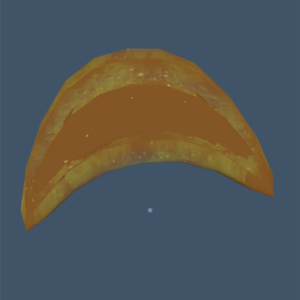Nitroplast: Difference between revisions
Oliveriver (talk | contribs) (Fill info box) |
Oliveriver (talk | contribs) (Filled out nitrogen-fixing plastids page) |
||
| Line 6: | Line 6: | ||
| cost = 50 | | cost = 50 | ||
| requiresNucleus = Yes | | requiresNucleus = Yes | ||
| processes = Nitrogen | | processes = Aerobic Nitrogen Fixation | ||
| enzymes = None | | enzymes = None | ||
| size = 2 | | size = 2 | ||
| Line 16: | Line 16: | ||
}} | }} | ||
Performs '''Anaerobic Nitrogen Fixation''' to produce '''Ammonia''' {{CompoundIcon|image=AmmoniaIcon.png|internalName=ammonia}} from gaseous '''Nitrogen''' {{CompoundIcon|image=NitrogenIcon.png|internalName=nitrogen}} and '''ATP''' {{CompoundIcon|image=ATPIcon.png|internalName=atp}}, producing one of the components of growth for cellular reproduction. More efficient than the prokaryotic '''[[Nitrogenase]]'''. | |||
== Requirements == | == Requirements == | ||
A cell must have a '''[[Nucleus]]''' to evolve '''Nitrogen-Fixing Plastids'''. | |||
== Processes == | == Processes == | ||
'''Aerobic Nitrogen Fixation''' | |||
Fixes atmospheric '''Nitrogen''' {{CompoundIcon|image=NitrogenIcon.png|internalName=nitrogen}} into '''Ammonia''' {{CompoundIcon|image=AmmoniaIcon.png|internalName=ammonia}} by expending energy. Rate scales with the amount of environmental '''Nitrogen''' {{CompoundIcon|image=NitrogenIcon.png|internalName=nitrogen}} and '''Oxygen''' {{CompoundIcon|image=OxygenIcon.png|internalName=oxygen}}. More efficient than the equivalent process in '''[[Nitrogenase]]'''. | |||
== Modifications == | == Modifications == | ||
No modifications. | |||
== Effects == | == Effects == | ||
No effects. | |||
== Upgrades == | == Upgrades == | ||
No upgrades. | |||
== Strategy == | == Strategy == | ||
We recommend replacing '''[[Nitrogenase]]''' with '''Nitrogen-Fixing Plastids''' when your cell develops a '''[[Nucleus]]''', as the latter can more efficiently generate resources needed for reproduction. | |||
As with '''[[Nitrogenase]]''', '''Nitrogen-Fixing Plastids''' are a sensible choice if you have '''ATP''' {{CompoundIcon|image=ATPIcon.png|internalName=atp}} to spare. Creating reproduction resources yourself removes a limiting factor on your ability to progress through generations more quickly. | |||
== Scientific Background == | == Scientific Background == | ||
TBA | TBA | ||
Revision as of 18:58, 23 February 2024
Performs Anaerobic Nitrogen Fixation to produce Ammonia ![]() from gaseous Nitrogen
from gaseous Nitrogen ![]() and ATP
and ATP ![]() , producing one of the components of growth for cellular reproduction. More efficient than the prokaryotic Nitrogenase.
, producing one of the components of growth for cellular reproduction. More efficient than the prokaryotic Nitrogenase.
Requirements
A cell must have a Nucleus to evolve Nitrogen-Fixing Plastids.
Processes
Aerobic Nitrogen Fixation
Fixes atmospheric Nitrogen ![]() into Ammonia
into Ammonia ![]() by expending energy. Rate scales with the amount of environmental Nitrogen
by expending energy. Rate scales with the amount of environmental Nitrogen ![]() and Oxygen
and Oxygen ![]() . More efficient than the equivalent process in Nitrogenase.
. More efficient than the equivalent process in Nitrogenase.
Modifications
No modifications.
Effects
No effects.
Upgrades
No upgrades.
Strategy
We recommend replacing Nitrogenase with Nitrogen-Fixing Plastids when your cell develops a Nucleus, as the latter can more efficiently generate resources needed for reproduction.
As with Nitrogenase, Nitrogen-Fixing Plastids are a sensible choice if you have ATP ![]() to spare. Creating reproduction resources yourself removes a limiting factor on your ability to progress through generations more quickly.
to spare. Creating reproduction resources yourself removes a limiting factor on your ability to progress through generations more quickly.
Scientific Background
TBA
